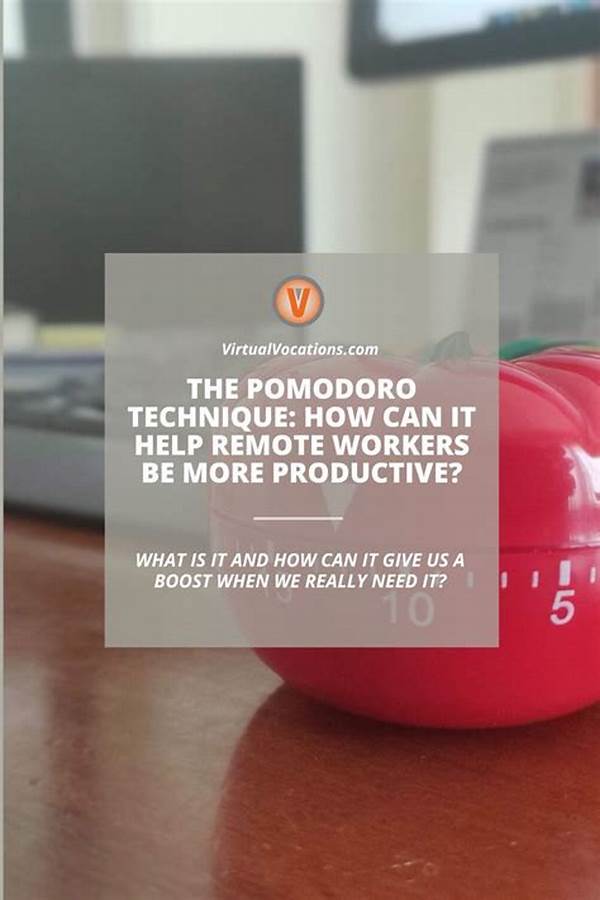- Pomodoro Method Resurges Among Remote Workers
- How to Use the Pomodoro Method Effectively
- Pomodoro Techniques Beyond the Basics
- Tags Related to Pomodoro Method Resurges Among Remote Workers
- The Pomodoro Method in Action: Real-Life Applications
- Rationale Behind the Resurgence
- Pomodoro Method Resurges Among Remote Workers: A Timely Solution
Pomodoro Method Resurges Among Remote Workers
In a world where deadlines loom larger than ever and distractions are only a click away, the Pomodoro technique is enjoying a renaissance among remote workers. Created in the late 1980s by Francesco Cirillo, the Pomodoro Method, named after a tomato-shaped kitchen timer, is a time management tool that breaks work into intervals, traditionally 25 minutes in length, separated by short breaks. Now, as remote work has become the norm for many, the effectiveness of the Pomodoro method for maintaining focus has placed it back in the spotlight.
Read More : Breaking Down Parkinson’s Law In Modern Work
Remote work poses unique challenges, from balancing household responsibilities to managing the constant influx of digital notifications. The Pomodoro Method resurges among remote workers as it offers a structured yet flexible approach that can enhance productivity and minimize burnout. The key lies in its simplicity—having discipline over one’s working intervals to accomplish tasks in a more focused manner.
In recent times, testimonials by remote workers from various fields reveal that the Pomodoro Method is not just a productivity hack, but a lifeline to sanity. Reports and research show that the structured breaks reduce mental fatigue, leading to better performance and job satisfaction. Coupled with modern technology, timers specifically designed for the method are now more accessible, ranging from apps to browser extensions, making it even easier for remote workers to integrate this method into their daily routines.
—
How to Use the Pomodoro Method Effectively
With the Pomodoro Method resurging among remote workers, integrating it into your workflow is easier than one might think. Here’s a brief guide:
1. List Tasks: Start by listing out the tasks you need to accomplish. Prioritize them by urgency and importance.
2. Set the Timer: Use a Pomodoro timer, setting it for 25 minutes. Focus solely on the task at hand, blocking out all distractions.
3. Work in Bursts: Work intensely and intentionally during this period. It’s crucial to resist the temptation to check your phone or any other diversion.
4. Take a Short Break: After each Pomodoro, take a 5-minute break. Step away from the computer to rest your eyes and stretch your legs.
5. Repeat: After completing four Pomodoros, take a longer break (15-30 minutes) to recharge fully.
Pomodoro Techniques Beyond the Basics
The key to the Pomodoro Method lies in its adaptability. Remote workers customize the interval lengths based on their personal needs and task nature. For instance, some might extend their work periods to 45 minutes if they find themselves in the ‘flow,’ while others may need shorter spurts to accommodate frequent interruptions, such as those from family or pets.
The resurgence of the Pomodoro Method among remote workers has also led to the development of digital tools that cater specifically to these adjustments. Apps now allow users to tweak timers, set specific goals for each session, and even track progress over time. This flexibility ensures that the Pomodoro method can seamlessly fit into varied lifestyles and working conditions, demonstrating both its relevance and endurance in modern productivity strategies.
—
Tags Related to Pomodoro Method Resurges Among Remote Workers
The Pomodoro Method in Action: Real-Life Applications
The Pomodoro Method stir among remote workers isn’t just theoretical. A scenario unfolds on a typical day for Rachel, a content writer working from her cozy home office. Her mornings are often a blur of virtual meetings and email catch-up, but by midday, she has a clear objective: to draft articles for clients. As tension from overlapping tasks builds, she reaches for her trusted Pomodoro timer.
Setting the timer for 25 minutes, Rachel immerses herself in creative writing, shielding herself from digital interruptions. When the alarm buzzes, she takes a brisk five-minute walk around her garden, gaining mental clarity from the fresh air. Her afternoon follows a similar rhythm — focused bursts of dedicated writing followed by short, rejuvenating breaks. By evening, with multiple Pomodoros under her belt, Rachel closes her laptop, content with her progress and ready for personal time.
This simple yet effective routine elucidates why the Pomodoro Method resurges among remote workers. It provides a framework that not only boosts productivity but also nurtures well-being, transcending professional boundaries to offer balance in all facets of life.
—
Rationale Behind the Resurgence
1. Increased Distractions in Remote Work: With more personal freedom comes more opportunities for distraction, making focused work essential.
2. Rise of Mental Health Awareness: Regular breaks and structured work intervals support mental well-being.
3. Integration with New Technologies: Apps and digital tools designed specifically for Pomodoro are accessible and user-friendly.
4. Flexibility: The method can be adapted for different tasks and personal productivity rhythms.
5. Community Support and Sharing: Online communities and forums offer support and shared experiences enhancing appeal.
6. Cost-Effective Solution: Requires nothing more than a timer, making it accessible and cost-effective.
7. Empowerment through Structure: Provides a sense of control amidst a chaotic digital work environment.
Pomodoro Method Resurges Among Remote Workers: A Timely Solution
The resurgence of the Pomodoro Method among remote workers illustrates an ongoing search for efficient productivity systems that can harmonize with the digital age. It is not just another trend, but a testament to the timeless efficacy of simplicity and focus. As remote work continues to evolve, embracing such methods may prove invaluable in maintaining balance and enhancing work achievements, contributing not just to professional success but also to personal contentment.



